

June 2022
|
Search the FOA website
FOA Home Page
Contact
Us
|
Sign
up for the FOA eMail Newsletter
Privacy Policy
Sections
News
Technical
Worth
Reading Q&A
Training/FiberU
Resoures
Safety
About
|
- Note we have
changed the format to place articles in
sections on one topic and all articles are
dated so you know if we repeat one - which
we often do when we think it's very
important!
DIY FTTH Now The Norm
FOA Network Design Certification
Example of Rural Broadband
NTIA Notice of Funding Opportunity
Should You Trust This Website?
Underground Construction Can Be Disruptive
Everybody Can Use Fiber U
Newsletter Sections
Click
on any link to jump to that section
News
POF Conference In Spain
California Middle Mile Network Specs
Fiber Optic Sensors Monitor Mt. Etna Volcano
AT&T, Corning Fiber Training Program
Technical
Useful New Products
Aerial cables
Measuring Loss - dB Again
Warning For Techs About Fiber Amplifiers
FOA Online Loss Budget Calculator
Worth
Reading Lots of interesting
articles
Q&A
Questions from our readers
Training/FiberU
Beware Of Fake FOA School, New FOA-Approved Schools, Fiber U
MiniCourses, making training classroom safe, onine
training, materials, more
Resources
New FOA YouTube Videos. Safety
About
FOA Certifications:
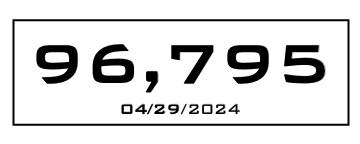
Time
To Renew Your FOA Certifications?
Special offer - 1/3
Off Renewal
Jobs
- See FOA Jobs
Web Page and FOA on

- The FOA Jobs
Web Page has been updated and a new page added
on Using your FOA
Training/Certification to Find the Right Job
in Fiber Optics
Where
Are The Jobs In Fiber Optics? FOA talks about
all the applications for fiber optics, what jobs
involve and the qualifications for the workers in
the field in this YouTube video.
Join The FOA eMail Newsletter
List
Want
to be notified when the FOA Newsletter is updated? Sign
up for the FOA eMail Newsletter. You can
also sign up from your cell phone: text "FOA" to
22828 (usual text message charges apply)
Trademarks:
The FOA CFOT® (Certified Fiber Optic Technician) and
Fiber U® (the FOA online self-study program) are
registered trademarks of the FOA.

Want to know more about fiber optics? Study
for FOA certifications? Free
Self-Study Programs are on "Fiber U®."
Looking for specific information? Here's the largest
technical reference on the web: The
FOA Online Fiber Optic Reference Guide.
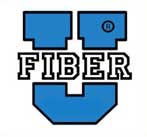
Free online self-study programs
on many fiber optics and cabling topics are
available at Fiber U,
FOA's online web-based training website.
FOA
Reference Books
Available Printed or eBooks
The fiber book is
available in Spanish and French
  
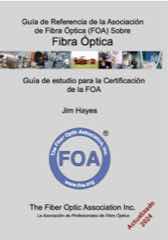
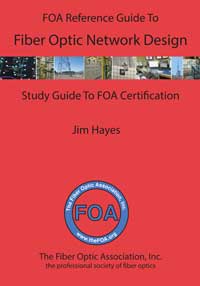 
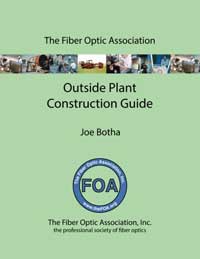 
Lennie
and Uncle Ted's
Guides are now also available as free iBooks on
iTunes.
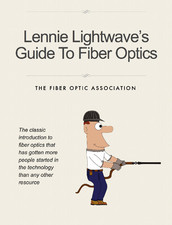

Click on any of
the books to learn more.
- Fiber
Optic Safety Poster to download and
print
FOA Videos on 
FOA
is a member of:




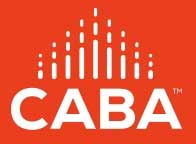
The FOA Newsletter is
edited by Jim Hayes - send your stories, leads,
ideas, comments to <jim @ foa.org>

Search the FOA Website With
DuckDuckGo
Top Stories From The 2021 FOA Newsletters
- The Archives: Past
Issues.
- Use these links to
read past issues or use FOA's
Custom Search to look for specific
topics on our website.
1/22, 2/22, 3/22, 4/22, 5/22, 6/22,
1/21, 2/21. 3/21, 4/21, 5/21, 6/21, 7/21, 8/21, 9/21, 10/21,
11-12/21,
1/20,
2/20,
3/20.
4/20,
5/20,
6/20,
7/20,
8/20,
9/20,
10/20,
11/20,
12/20,
1/19,
2/19,
3/19,
4/19, 5/19, 6/19, 7/19, 8/19, 9/19,
10/19,
11/19,
12/19
1/18,
2/18,
3/18, 4/18,
5/18, 6/18, 7/18, 8/18, 9/18, 10/18,
12/18.
1/17, 2/17, 3/17, 4/17, 5/17, 6/17,
7/17,
8/17,
9/17,
10/17, 11/17,
12/17
1/16, 2/16, 3/16,
4/16,
5/16,
6/16,
7-8/16,
9/16,
10/16,
11/16,
12/16
1/15,
2/15,
3/15,
4/15,
5/15,
6/15,
7/15,
8/15,
9/15 ,
10/15,
11/15
, 12/15
1/14,
2/14,
3/14,
4/14,
5/14,
6/14,
7/14,
8/14,
9/14,
10/14,
11/14,
12/14
1/13,
2/13,
3/13,
4/13,
5/13, 6/13,
7/13,
8/13,
9/13,
10/13,
11/13,
12/13
1/12
, 2/12,
3/12,
4/12,
6/12,
7/12,
8/12,
9/12,
10/12,
11/12,
12/12
1/11 ,
2/11,
3/11,
4/11,
6/11,
7/11,
8/11,
9/11, 10/11,
11/11,
12/11,
1/10 ,
2/10,
3/10,
4/10,
05/10,
07/10,
08/10,
09/10,
10/10,
11/10
1/09 ,
2/09,
3/09,
04/09,
05/09,
07/09,
08/09,
09/09,
10/09, 11/09,
12/09
1/08 , 2/08, 3/08, 4/08, 5/08, 6/08, 7/08, 8/08, 09/08, 10/08, 11/08, 12/08
12/07 , 11/07, 10/07, 09/07, 08/07, 07/07, 06/07, 05/07, 04/07, 03/07, 2/07, 1/07
12/06 , 11/06, 10/06, 09/06, 8/06, 7/06, 6/06, 5/06, 4/06, 3/06, 2/06, 1/06,
12/05 ,11/05, 10/05, 09/05, 08/05, 07/05, 6/05, 5/05, 4/05, 2/05, 01/05,
12/04 , 10/04, 9/04, 8/04, 7/04, 6/04, 5/04, 4/04, 3/04, 1/04,
12/03 , 11/03 10/03 9/03, 8/03, 7/03, 6/03, 3/03, 10/02 , 8/02, 5/02
Current Issue of FOA
Newsletter
Time To Renew Your
FOA Certifications?
To
keep your FOA certifications active, you need to
renew them when they expire. Now we have a new more
convenient way to renew - an online store at Paypal
- where you can quickly and conveniently use your
PayPal account or your credit card to renew your
certifications.
- You can now renew
with PayPal or a credit card
-
PayPal is available worldwide
Join FOA On
Social Media

FOA
has 3 LinkedIn Groups
FOA
- official page on LinkedIn - covers FOA, technology and jobs in the fiber optic
marketplace
FOA
Fiber Optic Training - open to all, covers
fiber optic technology and training topics
Grupo
de La Asociación de Fibra Óptica FOA (Español)
|
DIY (Do It Yourself) FTTH Has Become The "Norm"
Eight years ago, when real estate developer Greg Turton contacted FOA
asking if he could built his own FTTH network since no traditional service provider was
interested, FOA already knew enough to help him get started. Not long
afterwards, Kevin Short of the Anza Electrical Co-op asked a similar
question, we were even better prepared. Since then, we've lost count of
the hundreds of people and organizations who have contacted FOA with similar requests.
We even added DIY FTTH to the FOA Guide to help people understand that they can "do it themselves."
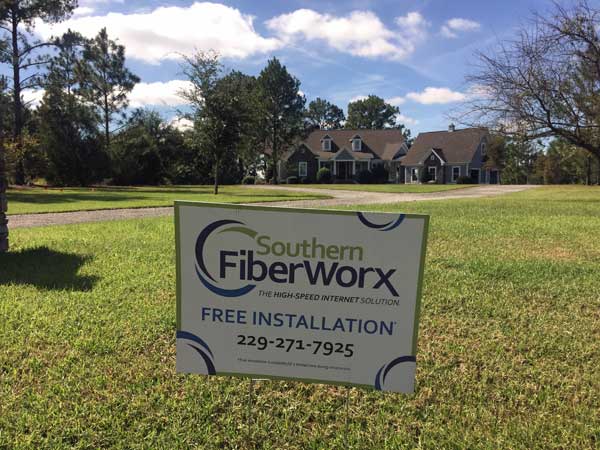 
Southern Fiberworx, Greg's FTTH ISP, and Connect ANZA were not the first
DIY FTTH networks. The beginnings of DIY FTTH were in cities where the
incumbent service providers were offering unsatisfactory service and
were unwilling to provide upgrades.
The level of Internet service that was expected had moved upwards after
Verizon began FiOS service and the Electricity Power Board of
Chattanooga built the first FTTH network to offer subscribers 1G -
gigabit Internet. Google came along about the same time, promising
gigabit FTTH and over 1,000 cities responded to Google's offer of
building the network for one lucky city.
Municipalities and utilities in the US which were willing to step up and
build their own networks encountered considerable roadblocks -
especially from the incumbents. The lobbyists for the major service
providers got many states to pass laws preventing public organizations
from building broadband networks to challenge the incumbents monopolies
and 19 states still have those laws on the books. Those that took the
option to the voting public for approval often encountered high-priced
opposition campaigns from the incumbents, often based on misinformation,
and most lost the votes needed to proceed with their own networks.
Private organizations like real estate developers, homeowners
associations and rural coops did not encounter those issues. For them it
was more a matter of finding the money and vendors to partner with
them. And avoiding consultants who were either incompetent or
unscrupulous. One group had a consultant take a large payment only to
come back and tell them they could not help them, but kept their money.
Several provided potential system designs that were inappropriate and
unnecessarily costly. We sat through a presentation by one group in a
small town that obviously had something to sell.
But many of the hundreds of contacts FOA has had in the last decade have
gone ahead and built very successful DIY FTTH networks, not only in the
US but all around the world. Many tell us they have used the FTTH Section of the FOA Guide and the free FTTH online training at Fiber U to get started properly, train their people and successfully complete their projects.
We expect to see many more DIY FTTH projects in the future. The events
of the last few years have shown the importance of broadband and the
FTTH networks needed to deliver it. In the US massive government funding
is going to be made available for building networks in unserved and
underserved areas.
Along with the money will come plenty of consultants
to help you get and spend it. It is well known that we lack sufficient
numbers of qualified fiber optic techs to build these networks, but we
also lack qualified consultants who can design networks and oversee
their construction. At least with techs, we have FOA CFOT certification
to qualify them. For consultants, perhaps they should be expected to have the FOA
CFOS/D Design certification. Read on....
Did You Know The FOA Has A Fiber Optic Network Design Certification?
CFOS/D –
Certified Fiber Optic Specialist in Network Design - is the FOA certification appropriate for
designers of fiber optic communications systems. This is a specialist certification covering the
planning, design and management of installation of fiber networks. The KSAs for CFOS/D cover fiber optic network design from concept to completion.
This is a conceptual course, not a course on using CAD or GIS to do the
actual design. It covers the process of designing a fiber optic network
from concept to operation, including what communications are needed, the
routing of the links, the processes of physical design including
choosing components, choosing contractors, supervising the building of
the project, documentation - a project from start to finish.
The CFOS/D certification can be very useful for network
owners, IT personnel, facilities managers, supervisors, network
designers, estimators or technicians involved in the design or
installation of fiber networks. This course is especially recommended
for network owners and planners who may not be familiar with the process
of fiber optic network design as it can make their jobs easier and
their projects better - and help them when working with consultants and contractors.
The FOA Design certification course is often taught along with a CFOS/H FTTH course when network owners are building their first FTTH networks.
A CFOT or equivalent basic knowledge of fiber optics and communications
networks is helpful for taking this course but not required. A review of
the basics of fiber optics is included in the course for those with no
background in fiber
optics.
The online design course is on Fiber U and like all the online courses, free.
Example Of Rural Broadband Confirms FOA Article
Back in the March FOA Newsletter,
we ran an article "More Thoughts On Broadband For Rural Areas" where we
showed a map on the state of Missouri showing how many unserved and
underserved areas are in a typical state. This month,
Telecompetitor ran a news item "Gateway Fiber Awarded $10 Million Grant to Expand Missouri Broadband."
Wright City, MO — Wright City-based Gateway Fiber has been awarded $10 million
as part of a $42 million grant to the State of Missouri from the
National Telecommunications Information Administration (NTIA) to expand
broadband internet coverage in underserved communities. Gateway received
the largest share of this funding state-wide.
The US Department of Commerce (DOC) announced in late February that
Missouri will receive the grant money to expand broadband coverage in
several communities where residents do not currently have access to
high-speed internet.
Locally, the grant funds will allow Gateway Fiber to reach nearly 5,000 homes and businesses in underserved communities in Lincoln and St. Charles County, including areas surrounding St. Paul, Josephville, Winfield, Moscow Mills, and Old Monroe.
Through Gateway’s future-proof fiber optic network, these areas will be
able to access the internet with hyper-fast symmetrical speeds up to 1
Gig, the same fast speeds available in major metropolitan areas.
Here is a map of those 5 communities:
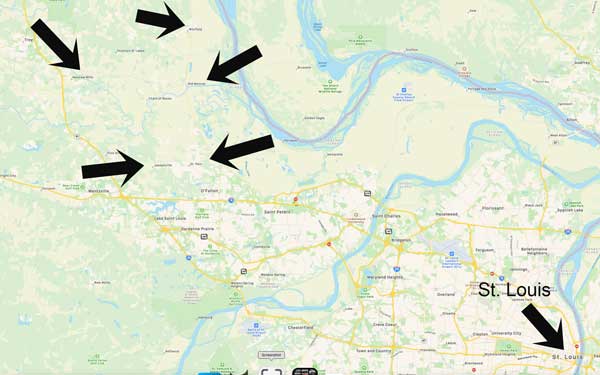
While these communities were in the unserved or
underserved areas, they are only ~50 miles (~80km) from the major city
of St. Louis.
Here are their populations (2010):
St. Paul 1,829
Josephville 376
Winfield 1,404
Moscow Mills 2,509
Old Monroe 265
These are exactly the kinds of towns we are referring
to as "rural;" small towns are where the bulk of the rural population
lives, not on farms.
The Cost
And the numbers are right in line with what we expect: $10 million for
connecting 5,000 homes and businesses is $2,000 per subscriber, what we
expect for rural broadband networks and, almost the same cost that was
quoted for AT&T to connect up homes in Oldham County, KY Kentucky as
reported in theNews section of the May FOA Newsletter.
Interesting Reading:
The NTIA Notice of Funding Opportunity (NOFO) - ONLY FTTH Projects Need Apply
You are going to see the term "NTIA NOFO" a lot now. It will refer to
the document describing the NTIA $43billion fund for broadband. If you
are at all interested in the program, we suggest you download a copy and
read it yourself. We did and found it extremely interesting.
The first thing we did was to search the PDF file for "fiber" to see if
fiber optics was called out specifically. We found 10 locations where
fiber was mentioned and we found these most interesting reading:
Page 7:
With respect to the deployment of last-mile broadband infrastructure,
the Program prioritizes projects designed to provide fiber connectivity
directly to the end user.
Page 14:
The term “Priority Broadband Project” means a project that will
provision service via end-to-end fiber-optic facilities to each end-user
premises.(Footnote 9)
Footnote 9: A project that will rely entirely on fiber-optic technology
to each end-user premises will ensure that the network built by the
project can easily scale speeds over time to meet the evolving
connectivity needs of households and businesses and support the
deployment of 5G, successor wireless technologies, and other advanced
services.
Page 42:
NTIA has determined that “Priority Broadband Projects” are those that
use end-to-end fiber-optic architecture. Only end-to-end fiber will
“ensure that the network built by the project can easily scale speeds
over time to ... meet the evolving connectivity needs of households and
businesses” and “support the deployment of 5G, successor wireless
technologies, and other advanced services.
There will be fiber: that's very important to those seeking grants and to organizations like
the FOA who will be involved in OJT and workforce development for these
projects.
Page 66: (Dig Once is called out also)
Any Funded Network deployment project that involves laying
fiber-optic cables or conduit underground or along a roadway must
include interspersed conduit access points at regular and short
intervals for interconnection by unaffiliated entities. Where a project
proposes to lay conduit, Eligible Entities shall require prospective
subgrantees to propose to deploy a reasonable amount of excess conduit
capacity and to propose a conduit access point interval as part of the
grant application process and shall consider the adequacy of the
prospective subgrantee’s proposed excess conduit capacity and access
points when evaluating the application.
Download your copy here: NTIA Notice of Funding Opportunity
Another NTIA page that is very useful is the NTIA "Broadband USA" page. It has a comprehensive listing of all the state broadband offices and a very good FAQs page.
Should You Trust A Website Called "broadband.money" ?
Almost immediately after the IIJA broadband program was announced, a website called "broadband.money"
popped up. Yes there is a higher level domain like "com," "net" and
"org" called "money" and you can guess what this is all about - money.
The home page with the photo of $100 bills just screams "GREED!!!"

Broadband.money describes itself on its home page as "The fastest way to
discover and win broadband grants." Then they invite you to "Enroll
today to find and win funding in your territory." To participate in this
- whatever it is - requires a very trusting - or perhaps gullible -
person. There is no indication of what or who is behind the website or
what they are peddling. The domain of the website,
"broadband.money" is registered privately, so there is no information on
the backers.
There is an email contact given, so we contacted them for more
information and they responded. It turns out to be the creation of a
Silicon valley software company called Ready.net
which sells software to ISPs but has a division that is a venture
capital organization. It is unclear what expertise they bring to the
process they are offering, although one of the people involved is
familiar with Tribal affairs.
In our contacts with them, we have encouraged then to be more open about their
motives. In the meantime, you can use the website to find the contacts
for each state's broadband office: https://broadband.money/state-broadband-offices (but the NTIA "Broadband USA" page
looks more comprehensive.
If you are looking for trustworthy information, we suggest you contact the Pew Charitable Trusts group.
Another startup organization, American Association For Public Broadband,
is comprised of actual municipal broadband organizations aiming to
build their own DIY broadband systems. According to an article in Community Networks,
"AAPB will have a more focused role by helping to facilitate better
communication between local, state, and federal officials as,
historically, lawmakers have almost exclusively been advised by the
lobbyists and trade associations who represent the monopoly interests of
Big Telecom." “Our
board is comprised of municipal officials. There are no vendors on our
board or incumbents. This is an organization for public officials
responsible for broadband projects.”
Help In Remembering Color Codes (More Free Stuff From FOA)
Recently FOA was asked if we knew of a pocket guide
to fiber optic color codes. We did not but recommended the page on color
codes in the FOA Online Guide, easily read on your smart phone of
tablet. But the idea of a pocket guide seemed to make good sense, so we
made one ourselves, as you can see here.
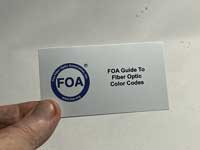 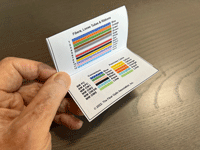
The FOA Guide To Fiber Optic Color Codes covers the basic color codes
for fibers and buffer tubes plus connectors and cables. On the back, we
added QR codes to link you to the FOA Online Guide for technical
information and Fiber U for free online learning.
FOA is sending these free to every new CFOT and every CFOT renewal in the US and Canada.
So when you get your FOA ID card, you get a FOA Color Code pocket
guide. Sorry we can't mail these outside the US, but we will share the
design with our schools around the world so they can make them locally
for their students too.
Print Your Own:
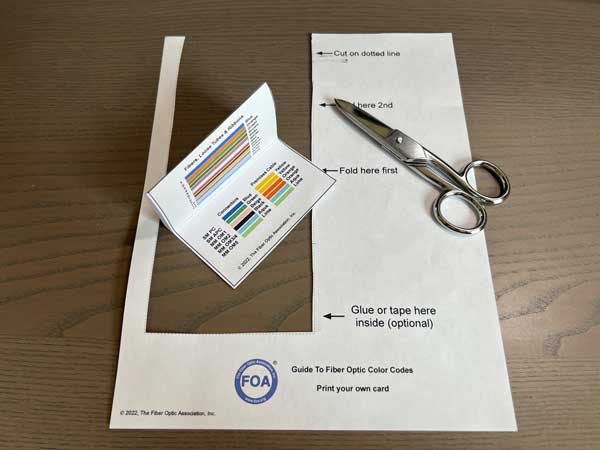
Go to the Color Codes page in the FOA Guide.
Follow the links to download the PDF files for either a pocket size
version you can print on a color printer, cut out and fit in a pocket or
a full page version you can save to your smartphone, tablet or
computer.
Underground Construction Can Be Extremely Disruptive
Sometimes we write about how several methods of underground
construction like microtrenching and directional boring can be done with
minimal disruption. But when things go wrong, they can be very
disruptive - and dangerous. We've run photos of directional boring
being done in downtown Santa Monica before, noting how it can be done
with precision, the driller following a tech with underground locating
equipment to ensure avoiding buried utilities.
But sometimes things go wrong. On May 3rd, a fiber optic construction
crew boring in he same area as the work we reported on in the FOA Newsletter in October 2019
hit a 2 inch (50mm) gas line causing a leak that took more than two
hours to shut off. The Santa Monica Fiber Department required all
businesses in the area - the primary shopping area in downtown Santa
Monica - to close for the afternoon. Santa Monica Daily Press.

Directional boring punctured 2" gas line in downtown Santa Monica (Photo by Emily Sawicki, Santa Monica Daily Press)
This is not the only time Santa Monica has been shut down by fiber optic
construction crews hitting gas lines. A year ago in the May 2021 FOA Newsletter
we reported that a fiber contractor made an even bigger mistake - they
hit a 16 inch (400mm) high pressure gas main. Quick action by the Santa
Monica Fire Department closed the area off and shut down electrical
service to prevent a major fire or explosion. FOA was unable to get any
details on how such a serious hit could occur.
The fact that two such events could happen in a major city like Santa
Monica shows how big a problem urban construction can be. Prevention
requires vigilance, careful understanding of documented underground
utilities and continuous active location during the boring process.
Who Can Use Fiber U? Everybody Can Use Fiber U!
Last month in the FOA Newsletter we had an article discussing the free Fiber U
online courses and how they can be used to help learn more about fiber
optics. We want to emphasize one point - FOA is free to anyone and
everyone. You don't need to be Certified by the FOA or be an FOA
Approved school to use Fiber U.
When the FOA was founded in 1995, our charter was "to promote
professionalism in fiber optics through education, certification and
standards." The founders wanted to provide educational resources for the
industry that would benefit everyone. Many of the founders were
manufacturers who recognized the need for an umbrella certification that
would help them in offering their own installer certifications for
their warranty programs. It would help educate their customers to
simplify the process of working with them to design, procure components
and install their networks.
Fiber U is a major part of the FOA's commitment to the fiber optic
industry. It's one of the services we provide free to the industry and
is often credited as a major contributor to the growth of the workforce
that is essential to our industry.
FOA also makes available a "Certificate of Completion" for those wanting
or needing evidence they have completed the course successfully. The
Certificate of Completion test uses our online testing service and has a
nominal cost for the test.
FOA welcomes everyone to use the free courses at Fiber U.
- We strongly encourage fiber installers who are
learning by OJT to use Fiber U to help their technical knowledge and
abilities to grow.
- All schools are welcome to use Fiber U, even if
you do not offer certification with your courses; right down to the
high school level.
- Employers, you can use Fiber U to build your
workforce and make them more productive. In today's world, hiring
experienced fiber techs is hard - they are all busy right now - but
hiring novices and training them by OJT using FOA's "OJT to Cert"
program can help solve your personnel problems.

Everybody's welcome to use Fiber U.
The FOA Guide To Fiber Optic Projects includes this timeline and comments on project planning and implementation.
FOA Broadband Planning Page. The FOA has a page devoted to
understanding the IIJA and how to obtain help in planning and funding
broadband projects.
More FOA Resoures
FOA Newsletter
Sections
News
Technical
Worth
Reading Q&A
Training/FiberU
Resoures
Safety About
|
News
Lots more news
in Worth Reading below
|
FOA Welcomes Another New School This Month:
Western Wyoming Community College, FOA Approved School #401
POF Conference To Be Held In Bilbao, Spain In September

The 30th International Conference on Plastic Optical Fibers (POF2022) will be held in Bilbao, Spain from September 26 to 28 at the University of the Basque Country.
The abstract submission for POF2022 is now open. Submit your abstract
and present your latest achievements and findings at the conference.
Visit Call for Papers at https://pof2022.org/call-for-papers/ for more details. If you have any questions, please contact POF2022 Technical Program Committee at email: pof2022@tisasa.es
Joseba Zubia
Program Committee Chair
https://pof2022.org/
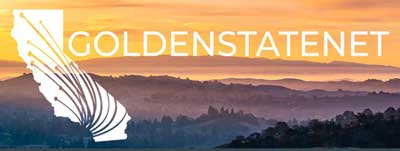
The California Department of Technology (CDT) released its draft map and
design recommendations for the proposed statewide broadband middle mile
network. The map outlines nearly 9,000 miles of infrastructure intended
to serve as a backbone for last-mile connection projects to underserved
and unserved communities throughout the state.
The link will take you to a very complete description of the network
which should be of interest to contractors in CA (obviously) but others
may learn a lot about how complex networks are designed.
Golden State Net Network details. (PDF)
Fiber Optic Sensor Monitors Volcanic Activity At Mt. Etna In Sicliy
Dr. Philippe Jousset, a scientist and researcher with
the GFZ German Research Centre for Geosciences (Potsdam, Germany), and
Gilda Currenti, a researcher at Italy’s National Institute of Geophysics
and Volcanology developed a method for monitoring seismic activity
around volcanoes using fiber-optic cables as sensors analyzing the light
backscattered in the cables when deformed by vibrations. The
technique—distributed acoustic sensing (DAS) with optical fibers—allows
for more accurate identification of volcanic events remotely and image
hidden near-surface volcanic structural features.
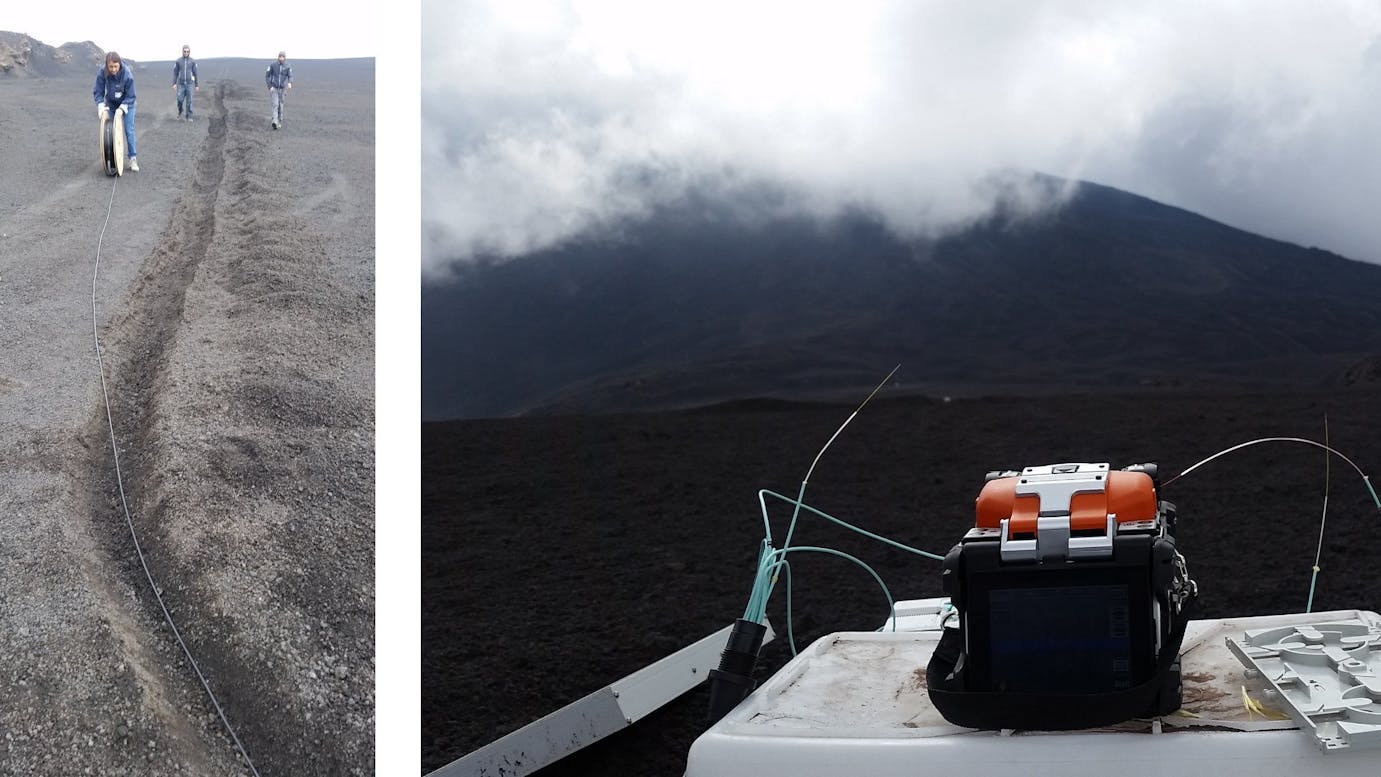
Putting their research into
practice, the team is monitoring one of the world’s most active
volcanos, Mount Etna in Sicily, Italy. They have been able to detect and
characterize strain signals associated with explosions in Mount Etna
and locate their origin with a 2D template matching picked and
theoretical wave arrival times. Wavefield separation has enabled
researchers to “incrementally investigate the ground response to various
excitation mechanisms,” and “identify very small volcanic events”
related to fluid migration and degassing.
Read more in Laser Focus World Magazine online
Wired Magazine also had a good overview of using fiber optic cables as sensors.
FOA Had A BUSY 2021
Below is a summary of some of the FOA accomplishments from 2021:
Top Stories From 2021 FOA Newsletters
Last Gasp For Multimode Fiber?
Who Lost Lucent? The Decline of America's Telecom Industry.
Things To Learn From A Town That Voted Down Fiber.
Can Tapping Fiber Reduce Cost?
How Many Fibers? Optimal cable Size.
Women Installers In Alaska.
FOA OJT To Cert Program.
FTTH Month - June FOA Newsletter.
Building Rural FTTH - Learning From The History Of Rural Electrification.
New FOA Guidelines For Training And Certification.
Warning For Techs Doing Restoration (Fiber Amplification).
New Pages In The FOA Guide
Fiber Optic Sources For Transmitters.
Midspan Access.
Loss Budget Calculator - Online.
FTTH Network Design. (plus updated pages in the FTTH section)
New Fiber U Courses
Fiber Characterization.
Basic Fiber Optics in Spanish
FTTH Update (Get the Certificate of Completion Free!)
Loss Budgets
How Fiber Works
Fiber Optic Color Codes
Reference Cables For Fiber Optic Testing
Basic Skills Labs - Link Demos
New FOA Publications
FOA FTTH Handbook.
New YouTube Lectures
FOA Lecture 61 Fiber Optic
Color Codes
Lecture 63 FTTH Network
Architectures
|
Technical
On fiber optic
technology, standards, equipment, installation,
etc.
The FOA
Update Page covers all the new technology
and applications we covered in this newsletter
recently. Now you can review all that new tech at
once.

Want to know more about fiber optics? Study
for FOA certifications? Free
Self-Study Programs are on "Fiber
U®." Looking for specific information?
Here's the largest technical reference on the web:
The
FOA Online Fiber Optic Reference Guide.
|
Useful Gadget For Installing Patchcords Indoors
Sometimes completing a FTTH home install or even a commercial project
requires running patchcords through walls or conduit. The problem is how
to do this without damaging the connector. Here is a gadget that was
designed to protect the connector on a patchcord in that kind of
install.
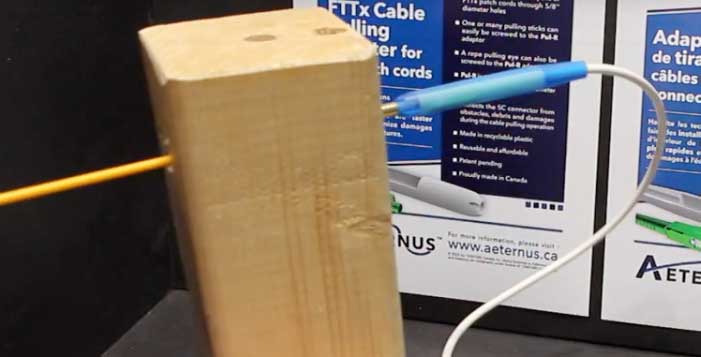
It's a plastic cover for a SC connector that provides
protection and connection to pulling rods or ropes/tapes. It's very
small so a small hole is all that's necessary to pull the cable. For
FTTH PON installs where only one fiber is needed, this seems to be a
really useful tool.
More info and video demo at PulR Technologies https://www2.pulr.tech.
FTTH Update In South Africa
Joe Botha of Triple Play Fiber Optics in South Africa
sent us a note to update us on what their FTTH network providers are
at-present doing in SA, using Nokia OLT’s and ONT’s.
Equipment has a 38 dB power budget: Tx +6 dBm & Rx -32dBm.
They do a cascaded split consisting of:
x2 at the OLT.
x4 at the distribution cabinet.
x16 at distribution points close to the homes = 128.
The obtainable distance: for a x64 fiber split = 27km and a x128 fiber split = 10km.
That's impressive and certainly expands the reach of a FTTH PON.
Joe and his instructors are teaching courses in SA regularly now using
basic guidelines for pandemic safety. Here's a recent course classroom:

VIAVI Introduces FiberComplete PRO Automated Fiber Tester

VIAVI has announced the new FiberComplete PROTM,
a unique solution with enhanced automation to significantly reduce time
and effort required for almost every aspect of the fiber test and
certification process including test setup and data exchange, results
analysis and on-board report generation.
Automation in testing has become the way to reduce both test time and requirements for tech training.
Learn more at the VIAVI website.
Anyone with experience using this product please contact FOA - we'd like your comments.
Aerial Cable Plant Installed Properly

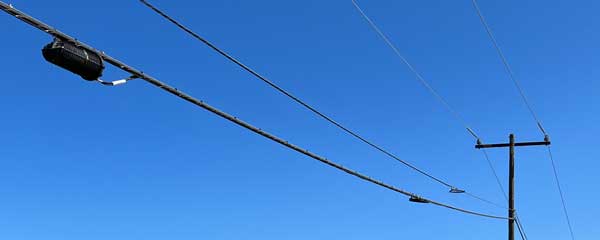
Kudos to the installers for American Tower who did
this really nice install in the San Gabriel Mountains NW of Los
Angeles. Note the carefully lashed cables and neatly installed snowshoes
and splice closure.
More Aerial Install Photos - No Comment Required...

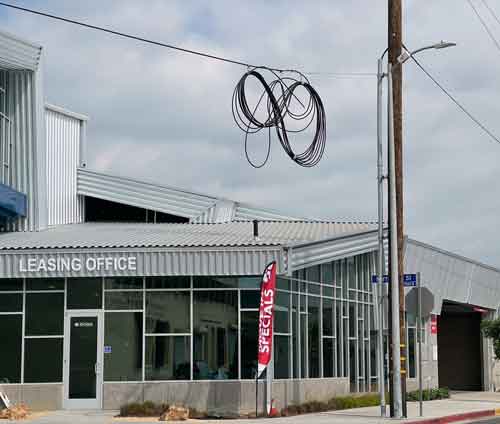

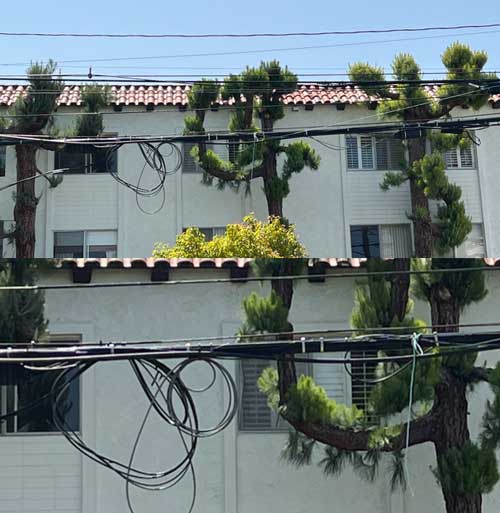
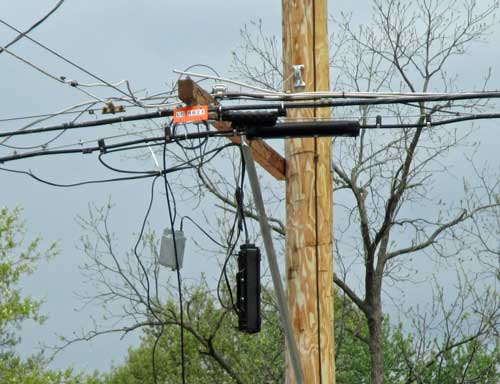
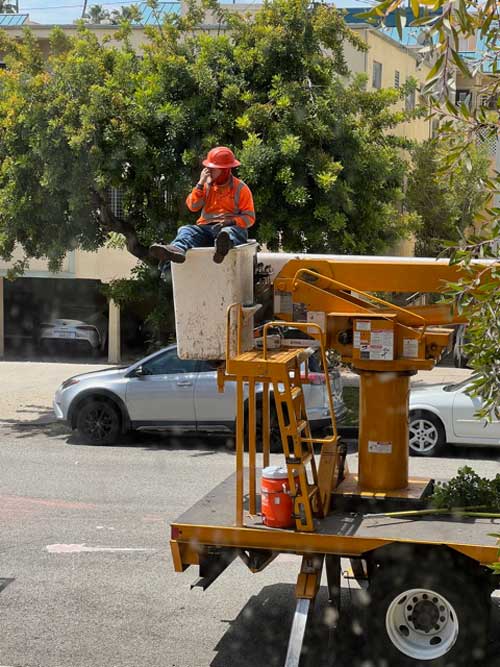
The Polarity Of Loss
Readers know we've been investigating the strange
reversal of polarity for optical loss measured in dB for some time. Here
is an interesting pair of definitions from a new international standard
adopted in the US.

The thing to note is attenuation or loss is referenced by
P(in)/P(out) - e.g. reference to the output signal, not the incoming
signal - in the basic equation The alternate equation used
P(out)/P(in) which which follows scientific and technical convention but
adds a negative sign to get the result to be a positive number.

But reflectance and return loss are referenced in relation to the
incoming signal, with does follow scientific and technical convention.
No consistency indicates a lack of knowledge of scientific and technical convention - just a desire to get rid of that pesky negative sign in the meter display.
Warning For Techs Doing OSP Restoration

FOA recently received an inquiry that was a new one; whether techs
working on restoring OSP links should be concerned about eye safety if
the link used fiber amplifiers. To answer this question, we had to do some research on fiber amplifiers.
The short answer is YES, you should be concerned. The long answer is
more technical and includes details that every OSP tech needs to know.
See "Fiber Amps And Restoration" in the FOA Newsletter Archives..
Try The FOA's Online
Loss Budget Calculator
FOA
has written many articles about loss budgets,
something everyone involved in fiber optics needs to
know and needs to know how to calculate. We've
created a online Loss Budget Calculator that does
the work for you. Just input your cable plant data
and it calculates the loss budget. It works on any
device, especially smartphones and tablets for field
use and even allows printing the results.

Bookmark
this page (especially on your smartphone): FOA Loss Budget Calculator
Online
|
Worth Reading
Each month we read
hundreds of newsletters and online articles. These
are the ones we think you will find "worth
reading."
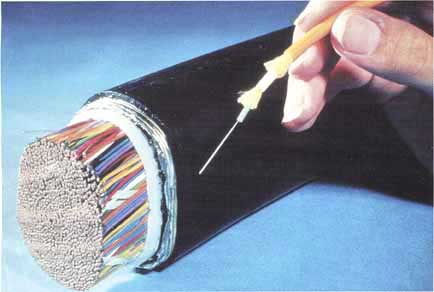 AT&T PR photo from the mid 1970s AT&T PR photo from the mid 1970s
The FOA's History
|
Worth Reading (And
Watching):
June 2022
"Outhorse" your email - Disconnect
from work and let the horses of Iceland reply to your emails while you
are on vacation. (Seriously - watch the video!)
Recruiting And Training Today's Fiber Optic Workforce - Learn the fundamentals to recruit and train new fiber optics - by FOA's Jim Hayes in ISE Magazine.
Explosive Fiber Broadband Expansion Drives Need for Fiber Technician Training Programs
- Telecompetitot - As fiber sees record-setting deployment levels, the
demand for fiber optic technicians is stronger than ever.
TodoFibraOptica todofibraoptica te mantiene informado y actualizado en todo lo relacionado con las telecomunicaciones por fibra óptica.
NTIA Notice of Funding Opportunity Information from the funding source on applying for US broadband funding
Wired Magazine has a good overview of using fiber optic cables as sensors.
2023 National Electrical Code® - Revisions to Cable Requirements from CCCA. Requirements for some fiber optic cables are moved from Article 770 to new Article 727.
May 2022
Google Video On Their Undersea Cables YouTube Slick but interesting video on how undersea cables are designed, built and used.
Corning's Sustainability Report 2021
Dilbert Comic 4/15/22: Wally solves the fiber optic cable supply chain problem
The Indiana Broadband Office is a one-stop-shop for all things broadband in Indiana. State of Indiana guidelines for community broadband projects.
2022 Submarine Cable Map depicts 486 cable systems and 1,306 landings that are currently active or under construction. Telegeography.
RTI Telecom Magazine from Brazil, in Portuguese. A revista RTI do mês de abril já está disponível online e recomendo a leitura de alguns artigos:
Comcast deploys hollow core fiber in low latency, multi-gigabit quest. Light in air goes 50% faster than in glass reducing latency. CI&M.
Ting, a rapidly-expanding ISP, explains how microtrenching helps them install fiber with minimal disruption.
Mississippi Electrical Coops Rapidly Connecting Rural Users. ILSR Community Networks.
April 2022
CENIC Technology Roundtables
- Videos of past webcasts on wIreless and CATV broadband with fiber
coming soon. Some of the best reviews of state of the art technology
from California's state of the art R&D and education network.
Construction Without Disruption - FOA President Jim Hayes' column in ISE Magazine
State of California Middle-Mile Broadband Initiative - California ALL program
Illinois (and Possibly New York) Poised to Fumble Federal Broadband Funds ILSR Remember the history of incombents getting state laws passed to prevent competition? Well, history repeats itself.
LA County Moves Closer to Municipal Broadband - ILSR Community Networks - WiFi on street lights
March 2022
Every State Has a Chance to Deliver a “Fiber for All” Broadband Future: Electronic Frontier Foundation
CI&M Magazine has a slideshow of bad aerial cable installs in their home area (New Hampshire) and in California (provided by FOA)
New York City: The Case for a Carrier-Neutral Infrastructure
- Broadband Communities - "there is growing momentum for open-access
infrastructure, which allows multiple providers to compete for
customers"
Pew Charitable Trusts has released a couple of new tools for state broadband offices preparing for the influx of federal funding. ILSR
PEW Charitable Trusts has a broadband initiative that aims to help local networks get started.
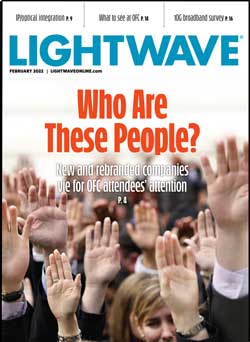
Read the latest issue of Lightwave Covering the OFC Conference, highlights: coherent and 10G PON.
February 2022
Fiber Optics Installed By The Lowest Bidder - ISE Magazine - by Jim Hayes, FOA President.
Building Broadband During Component and Worker Shortages
- Broadband Communities - Completing broadband builds requires
competent fiber optic techs, but training them requires understanding
how they learn - by Jim Hayes, FOA President.

The latest Issue of
dP-PRO, the "call before you dig" magazine, is
online. It's the 2022 Special Locate issue.
New Fiber Optic
Magazine In Spanish
Todo Fibra Optica is
a new digital magazine in Spanish for fiber optics
in Latin America. Jose Enriquez, editor of Todo
Fibra Optic magazine has many years
experience in the fiber optic industry so he knows
the industry well. FOA will be working with him to
share our extensive technical materials in Spanish.

Latest Issue.
Contact:
José Manuel Enriquez Mora, Editor
Todo Fibra Optica LLC
https://todofibraoptica.com/revista-ediciones/
+52 222 302 8224
jose.enriquez@todofibraoptica.com
Lightwave Magazine Is
Back!

Lightwave Magazine is back
after many years as only a online newsletter.
Lightwave was started in 1984 by Howard Rausch, a veteran
newsman, a gentleman and a scholar! (JH) We reported
on the demise of the printed version of Lightwave in
the FOA
Newsletter of March 2009. Lightwave is back as
a digital magazine, perfect for the times, and still
headed by Editorial Director Stephen Hardy, a
veteran of the fiber optic community with great
in-dept knowledge of the technology, companies and
people who make fiber optics what it is today. Lightwave's comprehensive
website continues too. All very worthwhile reading.
Statistics on US
Labor In Telecom
Eric
Pearson sent us some links to US Bureau of Labor
Statistics data on the US Workforce. Granted it was
updated in May 2019, but has lots of useful and
interesting information on where the work is and
what workers are paid.
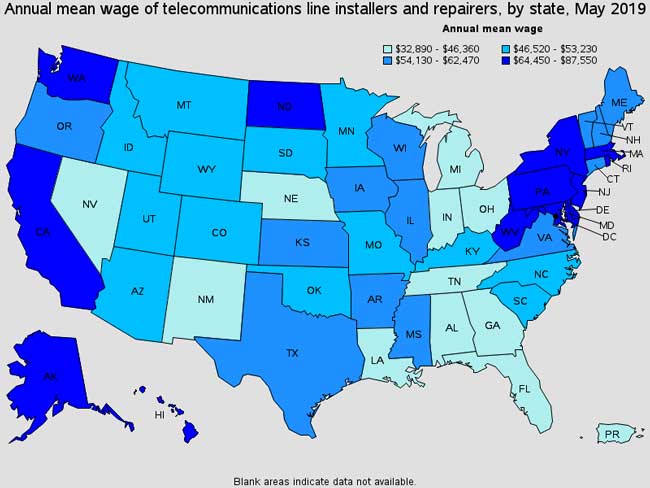
Read
the reports here:
Telecommunications Line Installers
and Repairers (Install and repair
telecommunications cable, including fiber optics.
Telecommunications Equipment
Installers and Repairers (Install,
set up, rearrange, or remove switching,
distribution, routing, and dialing equipment used in
central offices or headends. Service or repair
telephone, cable television, Internet, and other
communications equipment on customers’ property. May
install communications equipment or communications
wiring in buildings.
How Much Does A Cable Installer
Earn? Salary.com
1995-2020
- FOA's 25th Anniversary!
As
part of celebrating 25 years of serving the fiber
optic industry as its primary source of technical
information and independent certifying body, FOA
thought it appropriate to create a short history of
the organization and how it has developed to
help the fiber optic industry. We also wanted to
recognize the contributions many people have made to
the organization over the years that made FOA what
it is today.
The FOA history is now archived on the FOA
website where you can read it anytime or link to
it. Updated
info - dB, total internal reflection and science
projects,
Worth Reading - News
Summary - Past Links Worth Repeating
1983
Video of AT&T's First Test Of A Submarine
Cable System From the AT&T Tech
Channel archives (worth exploring!)
Richard
Epworth's Optical Fiber History from his work
at STL from 1966 with Charles Kao.
Communications Systems Grounding
Rules: Article 800 provides specific
requirements by
Michael
Johnston, NECA Executive Director of
Standards and Safety in EC Magazine
US Broadband Coverage By Service
Provider from the FCC
How
To Build Rural Broadband, Learning From History
In the August 2021
FOA Newsletter, we published a lengthy article on
rural broadband and compared it to rural
electrification in America in the last century.
Much of the comparison was based on an article
written in 1940 by a USDA economist, Robert Beall,
called "Rural Electrification."
If
you are interested in or involved in rural
broadband, we recommend you read the article "How
To Build Rural Broadband, Learning From History"
in the August 2021 FOA Newsletter and
read the Beall article also.
Recycling Fiber Optic
Cable - Contact:
Steve Maginnis
LD4Recycle/ CommuniCom Recycling
(Visit
website)
sm@LD4Recycle.com
803.371.5436
Sumitomo's Ribbon
Splicing Guide - download from
one of the leaders in splicing.
"Who Lost Lucent?: The
Decline of America's Telecom Equipment Industry"
This is a MUST READ for managers in telecom or any
industry!
This long and
well-researched and annotated article in American
Affairs Journal should be mandatory reading
for every high level manager in a telecom company -
or any other company for that matter. To summarize
the article, today, America has no major telecom
equipment company and fears the major suppliers of
equipment who are all foreign, especially the Huawei
from China. This article explains how America got
into this deplorable state.
OFS also has an excellent
website and blog of tech articles worth browsing.
IEC 60050 - International
Electrotechnical Vocabulary - An
extensive dictionary for fiber optics in English and
French. Highly technical - this is one definition:
"mode - one solution of Maxwell's equations,
representing an electromagnetic field in a certain
space domain and belonging to a family of
independent solutions defined by specified boundary
conditions"
If you are interested in restoration -
aren't we all? - you should also read this
article in dpPro magazine by FOA President Jim
Hayes: Damage Protection Requies
Looking Overheas As Well As Underground
- dpPRO Magazine - about the problems with
aerial cables. His previous article for the
magazine was New Techniques for Fiber
Optic Installation.
How much fiber optic cable is
manufactured each year? CRU Reports -
unsurprisingly China is by far the largest market
today
The Institute for Local
Self-Reliance weekly newsletter has
lots of interesting articles and links.
The Open Technology Institute at New America just
published “The Cost of Connectivity 2020,”
US Ignite and Altman
Solon issued “Broadband Models for Unserved
and Underserved Communities”
Universal access to broadband
is a cornerstone to a strong economy,
Achieving universal access will require
community partnerships. by Alfreda
B. Norman, Sr. VP, Federal Reserve Bank of
Dallas
FIBER TO THE FARM: The
co-ops that electrified Depression-era farms are
now building rural internet. Be sure to check out
the high-tech equine installation equipment.
Next Century Cities Newsletter
- News from cities around the US
including Detroit and New York plus small
Infrastructure Get Some
Respect, NY TImes "On Tech"
"The magic of the internet requires a lot of
very boring stuff behind the scenes. "
DIRT
Report On Damage To Utilities Common Ground
Alliance (CGA) annual DIRT report provides a
summary and analysis of the events submitted into
CGA’s Damage Information Reporting Tool (DIRT) for
the year 2018. The complete report is available
for download here. In addition,
there is an interactive dashboard that
allows users to filter the data more by
factors contributing to damages.
Structured Cabling News
- a website and weekly newsletter about cabling.
The Internet Master
Plan for New York City.
The New York City Internet Master Plan is a
comprehensive framework for the infrastructure
and services that provide connectivity to New
York City residents and businesses. This
Master Plan will guide City actions and
public-private partnerships to transform New
Yorkers’ access to this essential
infrastructure for generations to come.
Fiber Trivia From
Corning.
The
Future Of Work Is Skills - So Stop Worrying
About Degrees - The
reality is the future of work is about skills, not
just degrees. (FOA Newsletter Feb 2020)
The job market is hot. So why
are half of U.S. grads missing out?
VIAVI Books On
Fiber Optic Testing (2 volumes) - They're back!
 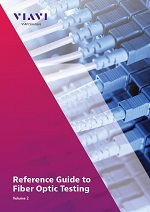
Besides
the FOA reference materials, two JDSU/VIAVI
textbooks, Reference Guide to Fiber Optic Testing,
Volumes 1 and 2, were used as references for
some of the FOA courses and are recommended for
instructors and students. The books are available
from VIAVI as eBooks and the everyone should
download them and recommend them to others.Download
yours now. Volume 1. Volume 2. Viavi Books
Ciena's Submarine Cable
Handbooks (4 to download)
Guidebook To MPO
Testing OptoTest
offers this complete guide to MTP®/MPO testing. In
this guide, you will learn all there is to know
about the different test methods, equipment
options, troubleshooting, and best maintenance
practices to ensure that you have the best testing
experience. Go here to download the book.
50th Anniversary of The
Development of Low Loss Fibers A history
of the development of low loss fiber, a fascinating
story by Jeff Hecht on the OSA (Optical Society of
America) website.
How OFS Makes Fiber
Interesting YouTube video on how fiber is made.
Perhaps a little too much "show biz" but
fascinating. If you have ever seen fiber
manufacture, look at this video. You will be amazed
at how big preforms have become!
How Nexans Makes Copper Cables
- compare the process to fiber - don't most of the
machines look similar?
The True Cost of Telco Damages
(what backhoe fade or target practice can
cost)
Rural Electric Cooperatives:
Pole Attachment Policies and Issues, June 2019.
Clearfield-FOA Certification
Training Clearfield is now offering
their customers an FOA
CERTIFICATION course. This course
provides a basic understanding of fiber optic
technology, as well as Clearfield product
knowledge and how Clearfield’s integrated product
systems work together in a fiber network.
Substandard Contractors - Fiber
Optic Knowledge Doesn't Always Trickle
Down (EC Mag)
Another Source Of
Articles On Fiber
FOA
President and editor of this newsletter Jim Hayes
has also been writing a column in Electrical
Contractor Magazine for almost 20 years now.
Electrical contractors do lots of fiber work and
this column has covered some topics they are
interested in including installation processes,
network design, fiber applications and a lengthy
series on dark fiber - what it is, how's its used
and how it benefits the growth of communication. A
recent web site redesign makes it easier to browse
all these articles - just go to http://www.ecmag.com/contributing-authors/jim-hayes
and you can see all of them. |
Q&A
When readers ask us questions, we genrally refer them to FOA
resources where they can find the answer to their question and many
more. We first send them to the FOA Guide
which is the table of contents for the FOA technical resources. There
they can find pages indexed by topic and a search engine for the FOA
website. It also links them to FOA videos and courses on our free online learning site Fiber U.
The FOA
Fiber FAQs Page (FAQs = frequently asked
questions) gathers up questions readers have
asked us (which first ran in this newsletter)
and adds tech topics of general interest.
|
Good Question!
Tech
Questions/Comments From FOA Newsletter Readers
June 2022
Differences in OTDR Traces
Q: What causes the differences in otdr traces for fibre cores that are in the same cable?
A: Several things can cause the fibers in a cable to have differences in their OTDR traces:
Differences in fiber from different production batches including fiber that may come from different preforms.
Differences in stress on the fiber caused by inconsistent cable design and manufacture
Of course differences in splices including stress on fibers in a splice
closure and terminations including stress on fibers in racks and panels.
"Mining" Cables In Data Centers
Q: Is there any documentation out there on best practices for DC cable mining? Any help would be greatly appreciated.
A: This has been a topic in premises cabling since first
proposed by NFPA for the NEC twenty years ago. FOA has gotten this
kind of question before for many different circumstances, but I must
admit that I know of no recommended procedures or standards for the
removal of abandoned cable.
Cable “mining” often refers to the removal of
underfloor cable, may apply to cables in trays and is hard to get
information online - search for “Cable mining” and you get links to
sellers of cables designed to be installed in mines (coal, salt,
minerals, etc.) underground!
The biggest problem with removing unused cables is
identifying the cables to remove. Underlloor cables are particularly
bad, it seems, since you have generations of abandoned cables, often
poorly marked, sometimes mixed with power cables. With metallic cables,
you can sometimes use an ancient telephone tool, a “toner” to trace
cables, With fiber you just have to be careful that you identify the
cable before you cut.
It’s always better to remove small sections, especially if you can tug
on the cable and verify it each time before cutting. We’ve seen photos
of an early data center with cable trays 2 feet deep by 4 feet wide full
of about 4,000 fiber optic cables. After seeing that you understand why
the new high fiber count cables (1728, 34456 and 6912 fibers) are
desirable!
Calibration of Fiber Optic Power Meters
Q: Why does this tester sold so cheap show the same value for 1310 and 1550?
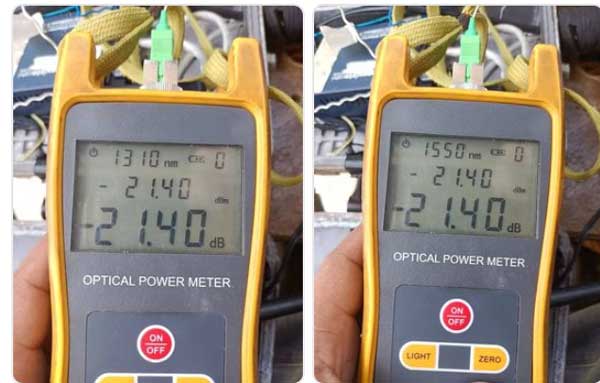
A: We’ve purchased and tested several
of these inexpensive meters based on questions from our instructors and
readers. They have a similar “feature” - they are not calibrated to
international standards of optical power, so when you measure dBm, the
result at any wavelength may vary considerably from a meter by a major
manufacturer who does calibrate properly.
However, these meters have a menu item that allows you to calibrate them
yourself. We've calibrated all the ones we tested to match our
calibrated instruments and after that they work OK.
Interestingly, they show loss as negative dB, which is how we think it
should be. Some large, famous manufacturers manipulated the standards to
make loss a positive number, so if you measure gain, it is considered a
fault.
May 2022
Designations For Fibers
Q: I'm currently working on a project involving optical fiber
with VMS signs, CCTV cameras and other ITS equipment. I was wondering if
there is a standard or a good practice which describe the typical
assignation for each optical fiber on a 6 fibers cable for
example? By that, I mean :
- fibers number 1 and 2 : VMS;
- fibers number 3 and 4 : CCTV;
- fibers number 5 and 6 : spares
A: There are several ways people assign polarity on duplex links.
The way you suggest is the most common I believe. Use the odd number
fibers to transmit in one direction, even number fibers to transmit in
the other direction and document the color codes.
Storing Fiber Optic Cable On Reels
Q: is there a "standard" for how to store a fiber optic cable reel?
A: This is another detail that has not in my knowledge ever been
included in a standard. However manufacturers usually put a note on the
reel to keep it upright - standing on the edges of the spool sides, not
flat on one side of the spool. If the fiber is to be stored for a
period of time, it should be stored in a cool dry place and the ends
sealed with electrical tape.
(Photo storing cable on reel)
Optical Power Of FTTH Signals
Q: I wanted to know on a fiber to home what is the optimal signal
strength I should receve at? I have a leg that is 21 km long I
receive at 1490 at -22 dBm is that to low, everything looks good on my
traces
A: The specifications for GPON are here. https://foa.org/tech/ref/appln/FTTH-PON.html
The standard for GPON calls for receiver power at -13dBm max to -28dBm minimum, so -22 dBm is OK.
April 2022
850 LED Test Source
Q: I need to test multimode fiber at 850 nm but sources are hard to find and expensive. Can I use a laser?
A: Multimode
fibers should be tested with an LED. Lasers have several problems in
multimode fiber that may cause untrustworthy readings. The problem is
that LEDs are no longer used for transmission systems; every MM system
now uses VCSEL transmitters, a surface emitting laser. As a result most
LEDs at 850nm for MM have gone out of production. Two engineers I know
who have been looking for them say there is now only a few sources and
the price is much higher that of a few years ago. We've been buying used
test sources on eBay for training.
105 Micron Fiber?
Q: I have a customer asking about 105um fiber. Does it exist? What is it basically used for? After FOA suggested a clarifying question to the customer: The
fiber is for Power over Fiber(PoF). The construction is 105um fiber
with 125um cladding. The question or assumption would be – The
termination would be the same as 50,62.5 or 8.3um with a 125um cladding?
A: The people who do laser surgery and power over fiber
use special step index fibers and SMA connectors. The power density can
be very high so the heat can build up in the cable. SMA connectors or
the metal ferrule swaged-on connectors are often used for their
all-metal construction with the ability to withstand heat and sometimes
the need to be drilled for special fiber diameters. Because of the high
power, the polish needs to be low reflectance, so we’d recommend using a
wet polish and end with a very fine polishing film - 0.3 microns or so.
Like polishing SM for DWDM.
Cleanliness is very important for these applications. I remember a call
from a doctor doing laser surgery who kept ruining cables because they
were dirty and the high power literally exploded the dirt and pitted the
ends. When that happens, sometimes they can be polished out but often
they are ruined. The same thing happened to the 120 inch telescope at
Lick Observatory when Joe Wampler tried using it to laser range to the
retroreflector Apollo 11 left on the moon. Exploding dust pitted the
aluminization on the mirror.
Gel Leaking From cables
Q: We have several instances where gel from inside
the fiber optic cable has leaked into the splice closure. I have seen
some information about sealing the ends of cables so that this doesn’t
happen but cannot find a specific method or procedure for this or what
to use for a sealant. Is this something that is common practice for
outside plant cables? The gel creates a mess and definitely makes
reentry for additional splicing more difficult. If there is a way to
prevent or minimize this I would like our technicians to start
implementing it.
A: When you install the cable, after inserting the cable
in the splice closure and/or the budder tubes in the splice trays, seal
the end with silicone RTV adhesive. It needs some time to cure but that
should prevent the gel leakage. Or next time, order dry water blocked
cable which will not have this problem.
Single Fiber DWDM
Q: Can you do bidirectional links on a single fiber with DWDM? (Dense Wavelength Division Multiplexing)?
A: A company Called Edge Optical Solutions sells
multiplexers for bi-directional DWDM on one fiber by using
adjacent wavelength channels for each direction. It is good to ~400km
with coherent transceivers but cannot use fiber amplifiers for
repeaters.
March 2022
Maximum Fusion Splice Loss
Q: We have set 0.4 dB as our max for all losses per splice
and my counterparts argue that customer quality will not suffer with a
1.0db-1.5db loss at a splice. What do you think?
A: We would argue that the issue with high loss splices is more
one of reliability. Most fusion splices of singlemode fiber are 0.05 to
0.1 dB A splice that has more than ~0.2dB loss probably has some
inclusion (dirt that got on the fiber after cleaving) or an air bubble
with means the splice is deficient in strength and may fail over time.
If the network is operating at high power with WDM and fiber amplifiers,
the inclusions or bubbles may produce heat which can cause failures. At
very high speeds or using coherent communications over long lengths, it
might affect dispersion.
Another Way Of Expressing dB?
Q: Just wondering what to
think about presenting dBm as a percentage of power, using either a
linear measurement or quadratic equation ?
I recently came across this article : [https://lnkd.in/eYkfpHzD] I
realise it's Wi-Fi signals here, but can you compare this to anything
concerning optical loss or gain , given we're still using dB and dBm ?
A: I had to read this 3 or 4 times to get the idea. Basically
he suggests converting dB, a nonlinear log scale, to a linear scale
expressed in %. Following his steps (assuming I understand his system) ,
100% = 0 dBm (1mw), 90% = -10dBm = 1/10mw = 10% of the original
signal, 80% = -20 dBm = 1/100 mW = 1% of the original signal.. So 80% =
1% of the original signal. And that’s where it seems a bit nonsensical.
70% would be 0.1% of the original signal,,,
We fail to see what this “new math” accomplishes.
OTDR AutoTest
Q: Would we say that OTDR 'Smart' test capabilities are commonplace on newer models or only on some manufacturers meters ?
Maybe it's additional software that can be thought of as an upgrade ?
A: Some form of “auto test” has been available on most OTDRs
for 20 years or more. Early versions were not very good; they usually
just made a test under some average test conditions and reported the
results. Modern OTDRs use more powerful computing power to make several
tests and determine which conditions are best for the fiber being
tested. By optimizing the range, pulse width, number of averages, etc.
it can usually produce fairly good results. We don’t think the cost of
the OTDR is an issue for new ones because users expect all of them to
have a good auto test function. As to whether an older unit could be
upgraded, that would depend on the manufacturer and if they still
support that product. An OTDR less than 5 years old should probably be
able to be upgraded.
February 2022
MM Splice-on Connector On Singlemode Cable
Q: I encountered a situation where a MM
mechanical connector was used on a SM fiber and passed on an OTDR test.
The client and I are interested in understanding how these connectors
could have passed?
A: The joint between a multimode and
singlemode fiber should have vrey high loss, ~17-20 dB, depending on the
mode fill of the MM fiber. However the short length of the MM fiber,
~10mm, might not be enough to cause the modes to fill in the short fiber
in the connector, resulting in relatively low loss.
Eric Pearson, one of the most knowledgeable people on connectors
expressed this idea then tested it with 100m singlemode connected to a
second singlemode cable. The second singlemode cable has an OM3 LC
unicam connector, An EXFO ftb-400 OTDR indicates a 2.09 dB drop. That is
way too much to pass a test but nowhere near the loss that could be
expected from the MM/SM joint. See the OTDR trace above.
November/December 2021
Fiber Optic Color Codes Reference Chart
Q: Has anyone made a fiber optic pocket reference chart that has cable
color orders, frequencies, or other commonly used info on it?
A: The FOA has a page on its Online Guide that covers color codes
(https://foa.org/tech/ColCodes.htm). It is the most popular page in the
FOA Guide! It works great with a smartphone.
Underground Utilities Location
Q: From an OSP engineer: Is there a resource for
underground utilities that we could use on our engineering designs? I
know some counties offer this info but is there a single resource for
all?
A: If you are in the US, the Common Ground Alliance (https://commongroundalliance.com , https://commongroundalliance.com/Tools-Resources/Resources-Library/Toolkits)
is a resource for designers and contractors looking for information on
underground utilities. Their “CGA Best Practices”
(https://bestpractices.commongroundalliance.com) is the best reference
for damage prevention.
Otherwise, the local authorities and utilities are the best source. The
department that issues permits is usually the place to start.
Even with that information, it is recommended that the contractor do
their own search using underground locating equipment before digging.
You may find this page in the FOA Guide on underground cable construction useful. ( https://www.foa.org/tech/ref/OSP_Construction/Underground_Construction.html )
Reflectance
Q: What is the importance of reflectance and all the other numbers in installing and trouble shooting a fiber circuit?
A: Reflectance has always been a secondary issue to connection
loss but has some important issues that need consideration. There are
two basic issues with reflectance, affecting with the output of laser
transmitters and creating background “noise” in a fiber link.
Reflectance can interact with the laser chip itself, causing laser
transmitters nonlinearities or random fluctuations in the output. The
background noise is a secondary issue, but can be seen in ghosts in an
OTDR trace. The light bouncing back and forth in the fiber that causes
ghosts will be added to the signal at the receiver end, adding noise to
the actual signal. Both these effects are more significant on shorter
links, for example FTTH or LANs using PONs (passive optical networks).
We always recommend using APC (angled physical contact) connectors on
short SM links. And most short SM networks do use APC connectors.
FOA tries to stick to the definition that reflectance is the light
reflected from a connection but some others call it “return loss.”
Return loss has been defined generally as the combination of reflectance
and backscatter from the fiber, and that’s how OTDRs measure return
loss. Standards vary in the definition sometimes.
Here is a FOA Guide page on reflectance that gives the basics and
explains how it is tested.
https://foa.org/tech/ref/testing/test/reflectance.html

The
word on the "Dig Once" program is getting out - FOA
is getting calls from cities asking us for
information and advice. Here are some links:
The DoT page on the administration’s Executive
Order: http://www.fhwa.dot.gov/policy/otps/exeorder.cfm
From the Council of State governments: http://www.csg.org/pubs/capitolideas/enews/cs41_1.aspx
From the city of San Francisco: http://sfgov.org/dt/dig-once
An article about Dakota County, MN: https://muninetworks.org/tags/tags/dig-once
And the
one to download and hand out:
A “How To” Guide from The Global Connect Initiative:
https://share.america.gov/wp-content/uploads/2016/04/6.-GCI-Dig-Once.pdf
Is There A Standard
For Fiber Optic Installation?
Another
question we get often is "Is there a standard for
fiber optic installation." The answer is yes, but
not from the usual standards groups you might
expect. Over 20 years ago, the National Electrical
Contractors Association (NECA) asked FOA to help
create a standard for installation. That standard,
ANSI/NECA/FOA-301 has been updated three times
already and is about ready for another update.
Unlike most of those groups who charge you a fortune
for standards, FOA covers the cost so ANSI/NECA/FOA-301
is available free from FOA.
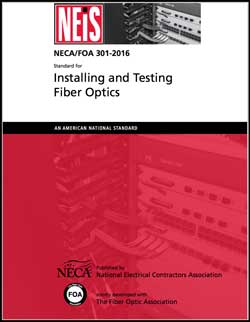
Download your free copy of ANSI/NECA/FOA-301
here (PDF)
Older
questions are now available here.
|
Training / FiberU
News and resources to help you learn more and stay
updated.
Find a
listing of all the FOA-Approved schools here.

Free online
self-study programs on many fiber optics and
cabling topics are available at Fiber U, FOA's
online web-based training website.
Free online training at
Fiber U
The FOA has >100
videos on  |
FOA Network Of
Approved Schools Continues To Grow
The
need for more fiber optic networks to support
broadband and wireless/5G networks has led to a
strong demand for more trained and FOA-certified
techs, and that has led to a demand for more
training organizations. FOA has been adding new
schools and certifying new instructors to meet the
demand. Here are two new schools this month and more
added recently.
New this month:
Western Wyoming Community College, FOA Approved School #401
Schools added
recently:
Arrow For Engineering #774, Amman, Jordan
Team Fishel #399, Virginia
School 398, Telecom Tech, Colorado
School 396 Optconn, Boston, MA
School 395 Fiber Wizards
(Knowledge on Demand LLC)
School 393,
Carolina's Solution Group
School 394,
Tri-County Career Center, Nelsonville, Ohio
School
388: Global Com of Sterling, Virginia, USA
School 389. CWA-JATC Telecom Training Center, San
Jose, CA
School 390 Northern Allied Communications,
Nespelem, WA
School 391 Lewis-Clark State College,
Lewiston, ID
School 392 Wallace Community College, Dothan,
AL
Complete listing of FOA Approved Training Organizations
Need A Fiber Optic Course Onsite? Invite an FOA School To Come To You
FOA often gets inquiries from an organization that
has personnel that needs training in fiber optics. Recent inquiries have
included contractors, a manufacturer of high-reliability products using
fiber optics and a cable manufacturer. In many cases, where there are
several people needing training, FOA can recommend a FOA Approved School
and Certified Instructor who will come to their location to teach a
class. The advantage is of course the savings in travel costs if
the class comes to you, but it also offers the opportunity to customize
the course to fit your needs, even use your equipment or work on your
components, so the training is more relevant to those taking the class.
Contact FOA to discuss the idea of a custom, on-site class to see if it will better meet your needs.
FOA/Fiber U
On-The-Job Training (OJT) Program
The
FOA Fiber U OJT program combines online study at
Fiber U with OJT with mentoring by experienced
co-workers and their supervisor to help new employees
develop into FOA-certified technicians in only
one year. Upon completion
of this program, the trainee will be prepared to
take the exam for the FOA CFOT (Certified Fiber
Optic Technician) and/or CPCT (Certified Premises
Cabling Technician), the most widely recognized
fiber optic and premises cabling certifications in
the industry.
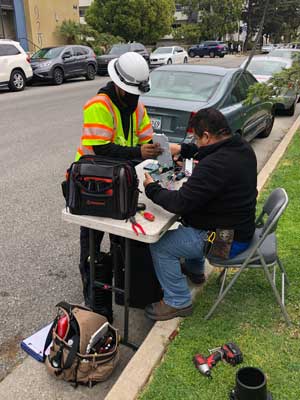
The FOA Fiber U “OJT-To-Cert”
program includes both fiber optics
and premises cabling (copper, fiber & wireless),
so it covers techs working in both outside plant and
premises jobs.
Like other FOA
programs, the OJT-To-Cert program is free. If you
and/or your company is interested in the FOA
OJT-To-Cert program,
contact FOA.
To explain how OJT
works and FOA's OJT-To-Cert program, FOA created a
short 10 minute YouTube video that explains what
OJT is, who uses it and how to use Fiber U to
organize and enhance OJT for new employees and
experienced workers too. Lecture 62: On
The Job Training For Fiber Optics Using Fiber
U
FOA
"Work-To-Cert" Program
Experience Plus
Online Study At Fiber U = FOA Certification
More techs have become comfortable with online
conferences, webinars and training. Many have
discovered that they can become FOA Certified using
their experience in fiber optics and study for the
FOA certification exams online at Fiber U. Thousands of
industry professionals have applied to the FOA
directly for certification without the need for
classroom training, based on their knowledge and
skills developed working the field. Since FOA
certifications are based on KSAs (knowledge, skills
and abilities), current techs already show the
skills and abilities required through their field
experience. FOA provides free online self-study courses at Fiber U for the knowledge
part to prepare you for FOA certification exams
which you can also take online.
If you are an experienced field tech interested in
certification, and FOA is the internationally
recognized certifying body for fiber optics, you can
find out more about the FOA "Work to Cert" program
here.
If you are already a CFOT, FOA also offers many
specialist certifications you can obtain based on
your experience as a field tech. See what's
available at Fiber
U.

Fiber U "Basic Fiber
Optics" Online Self-Study Course Now In Spanish
El curso de
autoaprendizaje en línea "Fibra óptica básica" de
Fiber U ahora en español
El sitio de
aprendizaje en línea de FOA, Fiber U, tiene más de
dos docenas de cursos de autoaprendizaje gratuitos
sobre fibra óptica y cableado de instalaciones.
Como era de esperar, el tema más popular es el
curso "Fibra óptica básica", que se utiliza para
iniciarse en la fibra óptica y como curso de
preparación para realizar el examen de
certificación FOA CFOT.
Ahora el curso básico
de fibra óptica está disponible en español,
utilizando el libro de texto FOA en español, la
sección de la Guía en línea en español y la
capacidad de YouTube para traducir subtítulos de
video al español. El curso funciona exactamente
como la versión en inglés con 10 lecciones, cada
una con cuestionarios y una opción para tomar un
examen de Certificado de finalización.
Para presentar el nuevo curso de
español Fiber U, el examen Certificate of
Completion es gratuito, así que dígaselo a sus
contactos.
Curso Básico de Fibra Óptica
de Fibra U en español.
New Fiber U Course: Fiber Characterization
FOA has added a new course at Fiber U on Fiber Characterization. Fiber
characterization is the process for testing long fiber cable plants for
its ability for carrying high speed communications. With so many
networks now operating at 100, 200, 400 or even 800 Gb/s, fiber
characterization is important, especially on older fiber optic cable
plants.The free Fiber U Fiber Characterization course is available in two forms, as a standalone Fiber U fiber Characterization Course with its own Fiber U Certificate of Completion and as a separate Lesson in the Fiber U Fiber Optic Testing course. This course is recommended for those studying for the FOA CFOS/FC Fiber Characterization certification.
Fiber U MiniCourses: Got An Hour Or Less?
Learn Something New About Fiber Optics.
FOA
has introduced a new type of Fiber U
course, the MiniCourse, a free online course you
could take in a short time, perhaps as you ate lunch
at your desk or took a coffee break. The
topics of these courses should explain what they are
about, and these are all very important topics to
fiber optic techs.
Fiber Optics In Communications
How Optical Fiber Works
Fiber Optic Network
Restoration
Fiber
Optic Connector Identification
Fiber U Color Codes
The Mysterious
dB of Fiber Optics
Fiber Optic Cable Bend Radius
Fiber Optic Link Loss And Power
Budgets
Fiber Optic Connector
Inspection And Cleaning
Fiber Optic Media Conversion
Fiber Optic Cable Midspan Access
Reading An OTDR Trace
Reference Cables For Testing
Fiber Optic Attenuators
The courses have two components, video lectures and
readings, that are complementary. As usual there is
a self-test to allow you to check your
comprehension. As with other Fiber U courses if you
desire, you can take a short test for a Fiber U
Certificate of Completion that costs
only $10.
All these free courses and many more
are available at Fiber U.
What Fiber Techs
Don't Know -
What We Learn From
FOA Certification Tests
As
FOA moves more testing over to our digital online
testing system at ClassMarker, we have access to
more data about our testing, including what
questions and topics on the tests are answered
incorrectly most often. Having this data gives us an
opportunity to evaluate the questions and how they
are stated, but more importantly it allow us to help
our instructors teach the subjects and us to change
our curriculum and online courses to emphasize these
particular topics. These are some of the topics that
we have noticed are answered incorrectly more often
in FOA and Fiber U tests.
Most of the questions missed are on testing.
1. OTDRs - particularly what information is in the
OTDR trace.
2. The difference between dB and dBm
3. Loss budgets - both the concepts and doing the
math
4. Insertion loss testing - single-ended or double
ended for testing patchcords or cable plants, how to
set 0dB references
5. Units of measure - fiber is measured in microns,
wavelengths in nanometers, etc.
At FOA, we're working to add Fiber
U MiniCourses on these topics and working with
our schools to emphasize these topics in their
classes.
If you are going to be taking a FOA certification
course or test in the near future, these topics
should be on your final exam study list.
What We Learn From Hands On Labs
We learn about students performance in hands-on labs
from the feedback of our instructors and our own
experiences too. One big problem is the use of hand
tools. Growing up today, you learn how to use
keyboards, mouses and touch screens, but decades
ago, you also learned how to use basic hand tools.
This is big enough of a problem that we're
considering adding some video lessons on basic hand
tools to prepare students for cable prep,
termination and splicing that require the use of
hand tools.
FOA Guide "Basics Of
Fiber Optics" Now Available Online in Portuguese
(6/2020)

FOA
has now translated the Basics of Fiber Optics
textbook in our Online Guide into Portuguese,
joining Spanish and French translations. For those
speaking Portuguese, we have the technical
information and for schools we also have curriculum
available.
Here is the FOA
Guide in Portuguese,
Spanish
and French
translations.
Time
To Learn - Online
Some
schools have been closed during the pandemic, so FOA
has been working with them to create new online
learning experiences that can in some cases lead to
certification online. FOA certifications are still
based on the KSAs - knowledge from the classroom,
skills from the labs and abilities judged by
instructors or proven by actual experience.
ZOOMing
Much of what we're doing benefits from the
capabilities of "Zoom." Others have created
videoconferencing apps, but none work so well,
especially with limited bandwidth. We've seen remote
labs that have an instructor showing students how to
use the tools they were sent then watching them
duplicate their actions. We have worked out methods
to use Zoom to proctor FOA's online certification
exams.
Blended
Learning
While most FOA schools have suspended in-person
training during this period, some are offering a
"blended learning" option. That means that
students sign up for a FOA certification course,
take the classroom sessions on Fiber U with the
assistance of a FOA certified instructor. Now
online instruction can include reviewing the
labs using the Fiber U Basic
Skills Labs, then when it's possible to attend
classes at the school, complete the hands-on
labs and take the FOA certification exam.
Offline Fiber U
FOA has also created offline Fiber U modules
to allow students with poor or limited
Internet access to use the Fiber U Basic Fiber
Optics and Premises Cabling programs without
Internet access. Contact FOA for information
on using this option.
Online Remote Labs
Alternatively, some schools are experimenting
with "remote labs," where the students get
sent tool kits and components and labs are
conducted by videoconferencing. Before the
labs, the students may watch demos by their
instructor on videoconferencing and/or review
the relevant "virtual hands-on" lessons in the
Fiber U Fiber Optics Basic Skills Labs
so they will already know the steps in the
exercises. And Fiber U has
the new Fiber U
DIY Basic Skills Lab lesson
with directions on how to
purchase inexpensive tools
online and use them to learn
basic fiber optic skills. Videoconferencing
allows the instructor to remotely monitor
their work and provide help as needed. Contact
the FOA for more information.
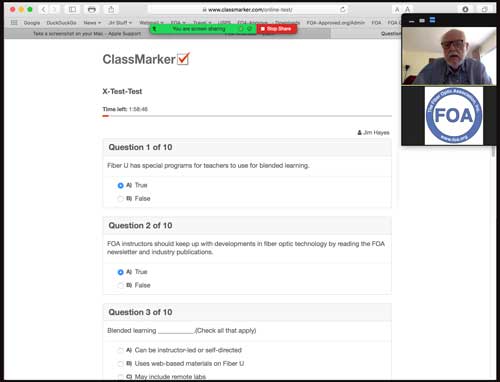
FOA Zoom Exam Proctoring
Online
Certification Testing
FOA has all its certification tests
available online, both for use by our
schools and by our direct "Work
to Cert" applicants. All FOA
certification tests require a proctor to
oversee the applicant taking the exam. In
this time of social distancing, getting a
proctor can be difficult, so FOA now has
procedures for online proctors
administering the exam. Contact
the FOA for more information.
OJT - On-The-Job-Training
Many novices get a job and learn on the job.
They usually have an experienced tech who helps
them gain the knowledge and learn the
skills they need to perform their job. Thinking
about this in relation to the FOA KSAs,
the knowledge, skills and abilities needed by a
fiber optic tech, the tech will learn
skills but not the basic knowledge that helps
them understand the processes involved. FOA can
offer help here with our FOA's
OJT-to-Cert Program,
using our Fiber
U online self-study programs. While the
tech learns on the job, they become a Fiber
U trainee, getting the knowledge they
need, while working under their "mentor" at
work. This is particularly good for
contracting companies who need techs but do
not have the usual training courses
available. Interested in OJT programs? Click
on the link below or contact FOA for
more information.
FOA's OJT-to-Cert
Program

FOA offers free online self-study programs at Fiber U.
Many users are preparing for FOA certification
programs - taking courses at our schools or using
the "Work-to-Cert" program. Some of our
schools are requiring Fiber U programs as
prerequisites for their classroom courses so they
can spend more time on hands-on activities.
FOA School Offers
Toolkit With Online Training

Slayton Solutions
(FOA Approved School #156) is offering a simple
fiber optic tool kit that includes a 29-piece set
of fiber optic tools and a power meter along with
training videos and online instruction for only
$499. 29 Piece Kit includes all tools and devices
a technician needs to install fiber optic
connectors and test optical power. Information on the kit is
available on YouTube. You can contact them for
more information at slaytonsolutions@sbcglobal.net
or https://www.fiberopticsinstitute.com
|
Publications /
Resources

|
Planning A Fiber Optic Project?
The FOA Guide To Fiber Optic Projects includes this timeline and comments on project planning and implementation.
More New FOA Video
Lectures On YouTube
Did you know YouTube
will close caption videos in many languages?
Here are directions.
FOA YouTube Video Describes
On-The-Job Training (OJT)
Lecture
62: On The Job Training For Fiber Optics Using
Fiber U
To
explain How OJT works and FOA's OJT-To-Cert program,
FOA created a short 10 minute YouTube video that
explains what OJT is, who uses it and how to use
Fiber U to organize and enhance OJT for new
employees and experienced workers too.
More New Videos
Including FTTH Series
As part of developing the new Fiber U MiniCourses,
we added several new YouTube videos:
Lecture 56 explains the issues of cable bend radius
limitations, typical cable specifications and how to
gage the proper radius or diameter when installing
or storing cable. Lecture 57 covers problems with
dirty connectors and how to inspect and clean them.
4
New Lectures on FTTH - #63-66 Plus #70 on Rural Broadband
New Lecture on Fiber Optics at Electrical Utilities
- #67
FOA Lecture 51 Fiber
Optic Restoration Part 1 - Causes of
Damage To The Network
FOA Lecture 52 Fiber Optic
Restoration Part 2 - Planning For
Restoration
FOA Lecture 53 Fiber Optic
Restoration Part 3 - Troubleshooting
And Repair
FOA Lecture 54 Fiber Optic
Connector Identification - New and old
FOA Lecture 55 The
Mysterious dB of Fiber Optics. -
Understanding dB
FOA Lecture 56 Fiber Optic Cable -
Bend Radius -
Important for Installers to Understand
Like all our YouTube lectures, they are
all short and easy to understand.
Did
you know YouTube will close caption videos in many
languages?

Sign in with Google to get translations for closed
captioning. Click on the settings icon (red arrow.)
Choose "Subtitles". English is the default
language. Click on the arrow after "English
(auto-generated) >". In the new window click on
"Auto-translate" and choose the language you
want.
FOA Loss Budget
Calculator On A Web Page 5/2020
FOA
has written many articles about loss budgets,
something everyone involved in fiber optics needs to
know and needs to know how to calculate. We recently
discovered how to get a spreadsheet ported to a Web
page, so we created this web page that calculates
loss budgets. We have an iOS loss budget app, but
with this web page, you can calculate loss budgets
from any device, smart phone, tablet, laptop, or
desktop computer that has web browsing capability.

Bookmark this page (especially on your
smartphone): FOA Loss Budget Calculator
Online
 We are continually updating the Online Reference
Guide to keep up with changes in the industry and
adding lots of new pages of technical information.
When you go to the FOA
Guide Table of Contents to see the latest
updates - look for
We are continually updating the Online Reference
Guide to keep up with changes in the industry and
adding lots of new pages of technical information.
When you go to the FOA
Guide Table of Contents to see the latest
updates - look for  . .
Recent updates:
FTTH
Updates: Added a section on FTTH Network Design,
updated Architecture and PONs (10G)
Color Codes For Fiber Optics
Fiber
Optic Projects - the FOA Guide to projects from
concept to operation
Coherent Communications Systems in
the FOA Guide.
Go
to The FOA Online Fiber Optic
Reference Guide.
FOA Reference Books
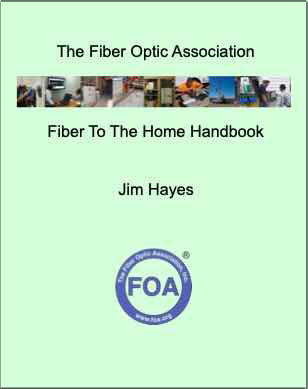
NEW:
FOA's FTTH Handbook: We've
gathered all our information on FTTH from the FOA
Guide and past issues of the FOA Newsletter and
edited it into a 112 page "FTTH Handbook." We even
added a section on planning and managing FTTH
Projects.
The Fiber Optic Association
Fiber To The Home Handbook is
available from Amazon in print and Kindle
editions.
 
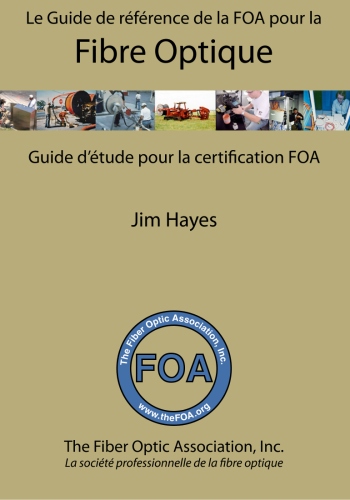      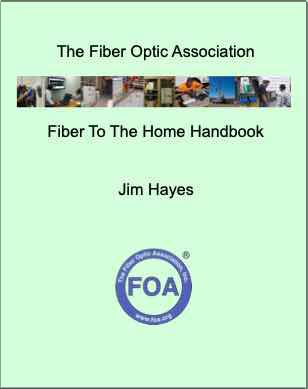
Fiber Optics (4 languages), Premises Cabling, OSP
fiber and construction, Network Design, Testing and
FTTH
The FOA has it's own
reference books for everyone working in fiber
optics - contractors, installers and end users as
well as for use as textbooks in classes at
educational institutions. They are available as
printed books or Kindle at much lower prices than
most textbooks since we self-publish and sell
online, cutting out the middlemen. Click on the
book images for more information. The Reference
Guide To Fiber Optics is also available in Spanish
and French (print and online) and Portuguese
(online only.)
Click on any book for more information
about it.
FOA
has reprinted

"Lennie Lightwave's Guide"
on its 25th anniversary in a special print
edition.
Lennie
and Uncle Ted's
Guides are online or as free iBooks on iTunes.


Click on any of
the books to learn more.
- Fiber
Optic Safety Poster to download and
print
Resources For
Teachers In K-12 And Technical Schools
Teachers in all grades can introduce their
students to fiber optic technology with some
simple demonstrations. FOA has created a page for
STEM or STEAM (science, technology, engineering, arts
and math) teachers with materials appropriate to
their classes. Fiber Optic Resources For
Teachers.
|
Safety
|
On Safety
The FOA is concerned about safety!
FOA
considers safety an integral part of all our
programs, curriculum materials and technical
materials. We start all our textbooks and their
online versions with a section on safety in the
first chapter, like this: Before
we get started - Safety First!
There are pages on the FOA Guide on Safety
procedures Including Eye Safety and. Digging
Safely
And a YouTube lecture: FOA Lecture 2: Safety When Working
With Fiber Optics
In our OSP Construction Section, these pages cover
many safety issues including those related to the
construction of the cable plant: Project Preparation And Guidelines,
Underground Cable Construction,
Underground Cable Installation
and Aerial Cable Installation.
There is even a safety poster for the fiber
activities: PDF Safety Rules For Fiber Optics
Other Safety Resources:
There is a toll-free
"call before you dig" number in the USA: Dial 811. See www.call811.com
for more information in the US. Here is their map of resources by states.
In Canada, it's "Click Before You Dig.com" They also have a page of resources by US states and Canadian provinces.
The Common Ground
Alliance has an excellent "Best Practices Guide"
online
- The US Department
of Transportation has a website called "National
Pipeline Mapping System" that allows one
to search for buried pipelines.
Why We Warn You To
Be Careful About Fiber Shards
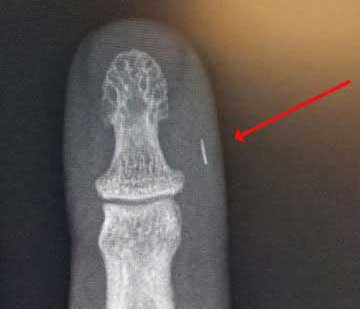
Photo courtesy Brian Brandstetter,
Mississauga Training Consultantcy
Safety Leader
Magazine
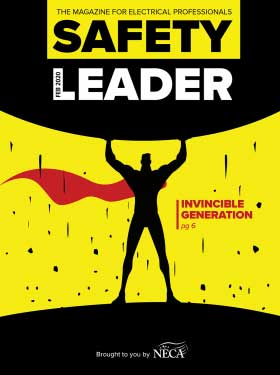
Safety Leader, a new quarterly magazine, informs and
educates electrical contractors on safety from
various angles—electrical, workplace, PPE,
regulations, leadership, line work, NFPA 70E, and
more. Safety Leader is bundled with ELECTRICAL
CONTRACTOR in February, May, August and November. To
receive Safety Leader subscribe to ELECTRICAL CONTRACTOR
magazine here or subscribe to the ELECTRICAL
CONTRACTOR newsletter here.
2023 Conference On
Damage Prevention In Tampa

Global Excavation Safety Conference Tampa, Florida
February 14-16, 2023
GlobalExcavationSafetyConference.com:
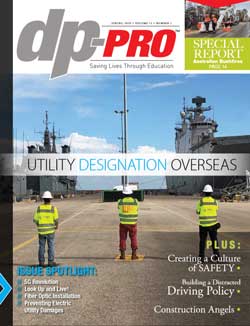
The magazine, dp-Pro, sponsor of the conference,
has also published it's latest issue with an
article by FOA on "New Construction Techniques
in Fiber Optics" and a overview of the FOA. You can read the magazine here.
When You Bury Marker
Tape, Bury One That Will Work (July 2021)
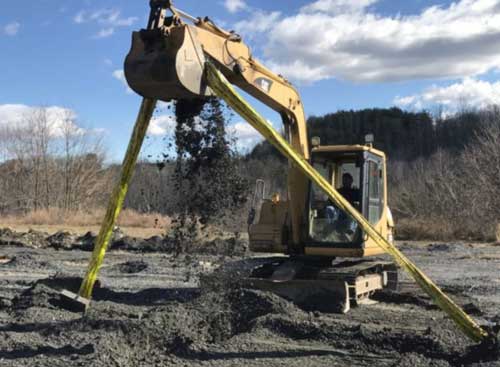
Signaltape® provides a visual
warning by ensuring tape is brought to the surface,
alerting the operator to the presence of a buried
utility. It includes a 3,000-lb. tensile strength
aramid fiber membrane, which ensures the tape is
pulled to the surface to alert the excavation crew.
Signaltape
comes in two sizes: 12″ x 1000′ or 6″ x
1000′.
FOA
Corporate Members - Products & Services
List
of corporate member information provided by FOA
corporate members listed on the FOA website.
|
FOA/About
About The FOA
- Contact
Us: http://www.foa.org
or email <info@foa.org>

FOA has a company page
and four LinkedIn Groups
FOA
- official company page on LinkedIn
FOA
- covers FOA, technology and jobs in the fiber optic
marketplace
FOA
Fiber Optic Training - open to all, covers
fiber optic technology and training topics
Grupo de La Asociación de
Fibra Óptica FOA (Español)
|
What is The FOA?
The FOA is a, international non-profit
educational association chartered to promote
professionalism in fiber optics through education,
certification and standards.
Founded in 1995 by a dozen prominent fiber optics
trainers and leaders from education, industry and government as a professional society for fiber
optics and a source of independent certification,
the FOA has grown to now being involved in numerous
activities to educate the world about fiber optics
and certify the workers who design, build and
operate the world's fiber optic networks.
Read More
FOA History
FOA Timeline of Fiber Optics
FOA was 25 years old
July 2020 - Read about FOA's history
Learn
More About FOA's History.
Contact
Us
The Fiber Optic Association Inc.
http://www.foa.org or email
<info@foa.org>
The
FOA Home Page

Want to know more about fiber optics? Study
for FOA certifications? Free
Self-Study Programs are on "Fiber U®."
Looking for specific information? Here's the largest
technical reference on the web: The
FOA Online Fiber Optic Reference Guide.

Free online self-study programs
on many fiber optics and cabling topics are
available at Fiber U,
FOA's online web-based training website.
|
-
Contact Us
The Fiber Optic Association Inc.
http://www.foa.org or
email <info@foa.org>
- Phone:
1-760-451-3655
The FOA Home Page
Fiber Optic Timeline
(C)1999-2022, The Fiber Optic Association, Inc.
|
FOA Logo
Merchandise
New FOA Swag! Shirts,
Caps, Stickers, Cups, etc.
The
FOA has created a store on Zazzle.com offering lots
of new logo merchandise. It has lots of versions of
shirts and other merchandise with "FOA," "Fiber U,"
"Lennie Lightwave" designs and more so you should
find something just for you! See FOA on Zazzle.
-

Your
Name, CFOT® - It pays to advertise!
The FOA encourages
CFOTs to use the logo on their business cards,
letterhead, truck or van, etc. and provides logo
files for that purpose. But we are also asked
about how to use the CFOT or CFOS certifications.
Easy, you can refer to yourself as "Your Name,
CFOT" or "Your Name, CFOS/T" for example.
Feel free to use the
logo and designations to promote your achievements
and professionalism!
Contact
FOA at info@thefoa.org to get logos in file format
for your use.
Privacy Policy (for
the EU GDPR): The FOA does not
use cookies or any other web tricks to gather
information on visitors to our website, nor do
we allow commercial advertising. Our website
hosts may gather traffic statistics for the
visitors to our website and our online testing
service, ClassMarker, maintains statistics of
test results. We do not release or misuse any
information on any of our members except we will
confirm FOA certifications and Fiber U
certificates of completion when requested by
appropriate persons such as employers or
personnel services.
Read
the complete FOA Privacy Policy here.
|






































































 .
.








